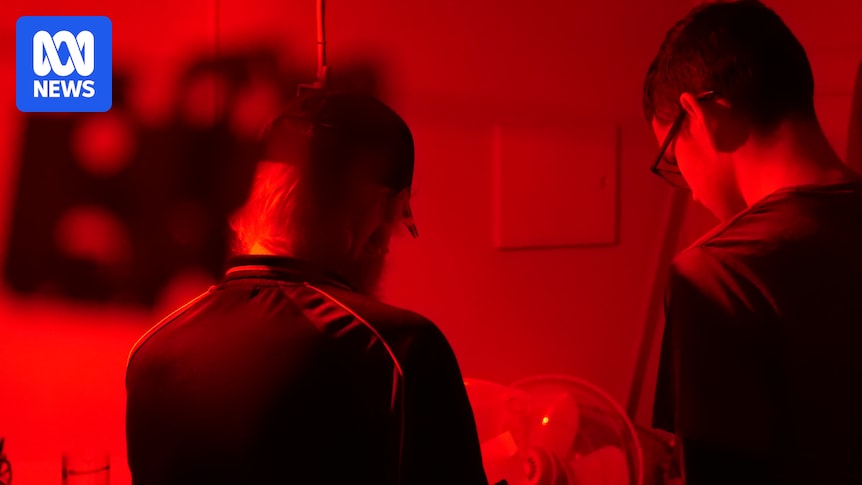In an era when digital photography is ubiquitous, film takes pride of place in an unusual darkroom in southern Western Australia.
Interest in the physical medium is booming at Albany’s ACE Camera Club, which uses a former hospital morgue to develop its analogue photos.
While renewed interest in film photography is slowly growing across Australia, the cost of chemicals, equipment and (above all) film is becoming increasingly expensive.
Albany club member Bob Symons says the steep prices make access to a photography club’s resources all the more important for aspiring photographers.
“It’s a lot of money [and] there’s a lot you can do with a phone nowadays,” he says.
The Albany ACE Camera Club uses an old morgue for its darkroom. (ABC News: Jamie Thannoo)
Pinhole cameras and infrared film
Mr Symons has been a fan of film for many years and relishes teaching photography skills to others.
His portfolio includes photos taken with homemade pinhole cameras and infrared film.
A photo of Perth’s skyline taken by Mr Symons with infrared film. (Supplied: Bob Symons)
He says the medium has a character and variety that cannot be replicated digitally.
“Film gives you an opportunity to be creative,” Mr Symons says.
“There’s endless things you can do here with different cameras and processes.
“No one can copy it on Photoshop, it just comes out with something unique.”
A street photo taken on a film camera with a wide angle lens and a slow shutter speed. (Supplied: Bob Symons)
Hospital morgue turned darkroom
The ACE Camera Club studio is at Albany’s Vancouver Arts Centre, formerly the city’s first hospital.
The group’s darkroom sits in a small, 19th-century shed, which once served as the hospital’s morgue.
Stacks of canisters, old camera equipment, tubs and chemicals fill the room.
The equipment doesn’t come cheap, but by pooling resources, the club helps aspiring photographers overcome one of the major hurdles of getting into film photography — the steep price.
After paying a membership fee, club members gain free access to the equipment needed to start taking analogue photos.
Developing film in-house is one of the measures bringing down the club’s costs. (ABC News: Jamie Thannoo)
Mr Symons joined the Albany camera club in 2014, seeking like-minded individuals.
In the decade since Mr Symons joined, the club has expanded to include the A-Team, a group for young people living with disabilities who want to get into digital and film photography.
Mr Symons is mentoring two A-Team members, Liam Hawker, 20, and Jasmine Ranezay, 22, who now want to dive into the world of film photography.
Jasmine Ranezay (left) and Liam Hawker (centre) are part of the new generation venturing into film. (ABC News: Jamie Thannoo)
The analogue charm of film photography has helped the art form’s revival among young people, with some drawing parallels to the renewed interest in vinyl records.
“It seems pretty interesting,” Mr Hawker says.
“All this old equipment, this science stuff, it’s pretty cool.”
Thanks to the club, Ms Ranezay has been able to start her own digital photography business, but she hasn’t stepped into the world of film yet.
“I 100 per cent want to,” she says.
“How it’s developed from nothing to the picture — its amazing.”
A pinhole photo of Albany’s former post office. (Supplied: Bob Symons)
The rising cost of film
In the early 2000s, film prices were at an all-time low as the industry fought to stay competitive amid the rise of digital photography.
Once smartphones gave everyone a camera in their pocket, the industry’s capacity was reduced and consumer costs began to rise.
Despite the resurgence of film photography in recent years, the cost of film remains high.
Mr Symons’s club has turned to some crafty solutions to keep prices down, including buying 17-metre rolls in bulk, using expired film and using coffee grounds to turn into a solution called caffenol to develop images.
Instant coffee is the key ingredient for caffenol, which is used to develop images. (ABC News: Jamie Thannoo)
Running their own darkroom also helps club members avoid third-party costs of sending the film to Perth or the eastern states to be developed.
“That’s part of what makes it interesting, it’s hands-on, there’s creativity,” Mr Symons says.
According to price tracker Analog Cafe, based on American and Canadian retailers, the average price of a 36xp roll of film increased from $14.79 in December 2019, to $23.41 in August this year.
While part of this can be attributed to the disruptions brought about by the COVID-19 pandemic, large price increases had begun before 2020.
Japanese company Fujifilm increased its film prices by more than 30 per cent in 2019.
As for the industry, one of the world’s largest film producers, Eastman Kodak has said the future is positive, with the company focused on advanced technology.
However, in its August earnings, the company said it was still being impacted by high costs such as manufacturing and the price of aluminium.
